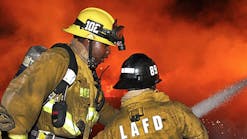CSI COVID-19: High-Rise Plumbing Systems in Hong Kong Hold Lessons
By PETE DeMARCO, EVP, IAPMO
Health officials in Hong Kong have determined that plumbing systems in certain high-rise buildings are implicated in recent cases of the COVID-19 coronavirus. Based on the limited information available, it’s clear that transmission paths that would allow for the virus to spread between individual apartment units in at least one high-rise building have been identified.
In order to understand how this has happened, it’s important to have some very basic knowledge of how wastewater systems work in high-rise buildings and to also look back at the SARS outbreak of 2003; the parallels are striking. In fact, the SARS virus is also a strain of coronavirus, so it’s not surprising that COVID-19 has been identified as having the potential to spread through plumbing systems.
High-rise buildings present unique challenges in plumbing design.
The following simplified explanation is intended to help illustrate the problem: When toilets in high-rise buildings are flushed, fecal matter and wastewater are discharged into a vertical wastewater pipe, called a “drainage stack.” As the wastewater descends in the stack, it creates pressure changes within the pipe. The wastewater flowing down a stack will push air down ahead of it and drag air behind it, creating both positive and negative pressures within the drainage system. These pressures can affect trap seals by either siphoning the water or pushing the water out of the trap. A second vertical pipe, called a “vent stack,” typically runs parallel to the drainage stack and introduces air into the drainage stack every fifth floor to avert excessive changes that could deplete trap seals and allow contaminated air and aerosols to enter apartments on other floors.
When the SARS outbreak occurred in 2003, problems with dry traps were indicated, allowing contaminated air and wastewater aerosols to enter into apartments on lower floors through floor drains that are required by Chinese and many other Asian national construction codes. A full explanation of how the SARS outbreak occurred and technical solutions providing health and safety associated with proper plumbing practices can be found in The Health Aspects of Plumbing, a publication produced by the World Health Organization and the World Plumbing Council.
Sadly, with the current coronavirus outbreak in Hong Kong, history seems to have repeated itself.
According to Associated Press, a 2016 Hong Kong Housing Department policy change has allowed tenants in certain high-rise apartments to alter the pipe design in their bathrooms without requiring an inspection by a plumbing official, causing the problem that might have helped spread COVID-19. In one of the apartment units, the vent pipe was completely disconnected inside the bathroom, apparently by the occupant, which provided a pathway for contaminated air to enter the apartment, especially when the bathroom ceiling fans were activated. When health officials became aware of this problem, the building was evacuated, hopefully limiting the number of additional illnesses among building residents.
Can the COVID-19 coronavirus be spread in high-rise buildings in the United States in a similar manner? In short, the answer is yes, but unlikely. Due to U.S. plumbing codes, any modification to a building’s water, waste or vent system must be performed by a qualified professional and necessitates an inspection by a code official. In addition, wastewater stacks and vent pipes are typically hidden behind walls in high-rise buildings, reducing the opportunity for residents to easily cut into pipes and create unsafe conditions.
Both the SARS and the current COVID-19 coronavirus outbreaks in Hong Kong illustrate the importance of proper plumbing design and practice in keeping building residents safe from disease and the profound problems that can develop when unqualified individuals decide to work on building water systems.
The axiom “the Plumber Protects the Health of the Nation” is more than a slogan. Improper deviations to building plumbing systems can, and indeed often do, result in very significant loss of life and property.
The author is executive vice president of Advocacy and Research for the International Association of Plumbing and Mechanical Officials (IAPMO) Group, based in Ontario CA (US). He can be reached at [email protected].









